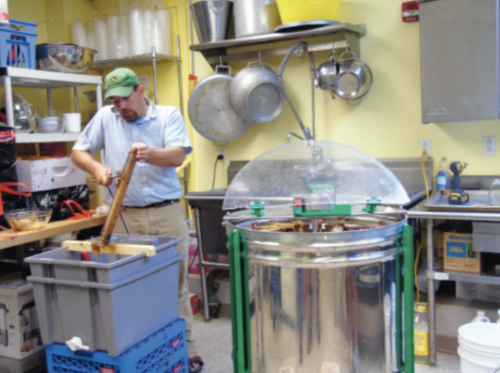By Al Mazzoli, Staff Writer
In a small room at the Friends School at Haverford, Eli St. Amour performs a honey extraction. A few people stand around the centrifuge, a big silver contraption supported by green metal bars and cinder blocks, in the middle of the room. St. Amour lifts frames from a box and scrapes wax caps off them with a heated metal tool. He passes the wax cappings around in a glass bowl for tasting. He has arranged step stools around the centrifuge so people can peer in.
When Eli St. Amour was twelve years old, he went on a similar field trip like the one he is leading now. He started his first hive the very next year, making and selling honey and beeswax lip balm. Eventually, he started teaching others how to keep bees. He now tends to hives at several schools, including Bryn Mawr and Haverford Colleges. The Bryn Mawr hives have been around for two years, and the Haverford hives since 2014.
St. Amour also teaches a beekeeping course during the summer, where students shadow him and learn the trade. They wear full bee suits, check the drones to make sure they’re healthy, and sometimes eat honey straight from the hive. They feed the bees and add more boxes when the bees run out of space. St. Amour says that many people who take the course end up starting their own hives. “There’s no tests, there’s no grade,” he says. “It’s pure education, you show up, you learn. You don’t show up, you don’t learn.” Currently there are five beekeeping apprentices at Bryn Mawr.
At the Friends School, he holds the empty frames to the light, making the white, empty cells appear translucent. He points out how the cells are staggered on either side, so that the edges of some overlap the centers of others, and explains how this provides more stability to the structure. They’re in the shape of hexagons because that’s the strongest shape for the amount of honey that the bees produce. Most of his bees are Italian honey bees, which are notorious for being gentler than other kinds, and for producing more honey.
The centrifuge spins the frames around until all the honey drips out through a tap in the bottom and into a metal bucket. St. Amour says that he can tell some of the honey is from later in the season, because of its darker color, which is caused by the bees are landing on different flowers. To remove the frames, he uses a smoker, which makes the bees fly to the bottom of the hive. He then removes the frame, brushes off the bees, and extracts the honey.
When asked about getting stung, he explains that, “you can tell if a dog’s being aggressive or if a dog’s being friendly…I can do that with bees.” He didn’t always used to wear a suit, because sometimes he couldn’t get one. Instead, he learned how to do his work quickly and calmly to minimize the risk, and also learned to get used to being stung. He says he doesn’t mind if he gets stung, but he tries to protect others if he can help it.
At Friends School at Haverford, a stray bee wanders into the room as he talks. “I don’t know how that bee got in here,” says St. Amour. The bee flies around the bottom of the centrifuge. He picks her up with his bare hand and places her into an empty honey jar, setting a plastic lid over the opening so she can’t get out. If she gets out, he says, she will go find the other bees and communicate to them where the honey is, using a triangulation system that involves the hive, the nectar source, and the sun.
At the end of the extraction, St. Amour says that he’s going to bring the empty frames back to the hives, where the bees will either eat the remaining honey traces or save it, to be collected in the next a honey extraction. At the end of his demonstration, St. Amour says he hopes to make his beekeeping business a full time endeavor.
Photo by Sofia Mondragon
